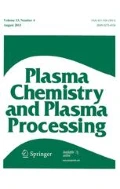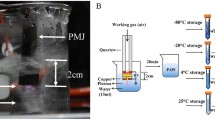Abstract
In the present work, we have studied the inactivation of Candida albicans (C. albicans) and lemon (Citrus limon) spoilage fungi using plasma activated water (PAW). Air and N2 are used as plasma forming gases for PAW preparation. Optical emission spectroscopy is used to determine various active radicals and species present in the air and N2 plasma. The present study shows the changes in physicochemical properties and reactive oxygen–nitrogen species formed in PAW. Furthermore, the fungicidal efficacy of PAW is investigated on C. albicans. The role of oxidizing potential of PAW and PAW treatment time with fungi (C. albicans and Citrus limon spoilage fungi) is investigated in the present work. Results showed high oxidizing PAW can achieve 6 + log10 CFU ml−1 reduction in fungi even with low treatment time. Morphology analysis by HR-SEM, leaked nucleic acids and protein measurement by UV–visible spectroscopy, and PI binding red fluorescence of cells showed PAW treatment with C. albicans damaged the membrane of cells due to which leakage of extracellular materials occurred that led to cells death. The present study also reveals the long-term fungicidal efficacy of PAW on C. albicans and Citrus limon spoilage fungi.












Similar content being viewed by others
Data Availability
The datasets generated during and/or analyzed during the current study are available from the corresponding author on reasonable request.
References
Howard DH (2002) Pathogenic fungi in humans and animals, 2nd edn. CRC Press, London
Talbot NJ (2003) On the trail of a cereal killer: exploring the biology of Magnaporthe grisea. Annu Rev Microbiol 57(1):177–202
Pessu P, Agoda S, Isong I, Adekalu O, Echendu M, Falade T (2011) Fungi and mycotoxins in stored foods. Af J Microbiol Res 5(25):4373–4382
Pitt JI, Hocking AD (2009) Fungi and food spoilage. Springer
Brock D, Alcamo IE (2006) Infectious fungi. Chelsea House Publishers, United States
Akpan A, Morgan R (2002) Oral candidiasis. Postgrad Med J 78(922):455–459
Calderone RA, Fonzi WA (2001) Virulence factors of Candida albicans. Trends Microbiol 9(7):327–335
Hoppanová L, Medvecká V, Dylíková J, Hudecová D, Kaliňáková B, Kryštofová S, Zahoranová A (2020) Low-temperature plasma applications in chemical fungicide treatment reduction. Acta Chimica Slovaca 13(1):26–33
Guynot ME, Marín S, Sanchis V, Ramos AJ (2005) An attempt to optimize potassium sorbate use to preserve low pH (4.5–5.5) intermediate moisture bakery products by modelling Eurotium spp., Aspergillus spp. and Penicillium corylophilum growth. Int J Food Microbiol 101(2):169–177
Fujikawa H, Itoh T (1996) Tailing of thermal inactivation curve of Aspergillus niger spores. Appl Environ Microbiol 62(10):3745–3749
Assuncao E, Reis TA, Baquiao AC, Correa B (2015) Effects of gamma and electron beam radiation on Brazil nuts artificially inoculated with Aspergillus flavus. J Food Prot 78(7):1397–1401
Begum M, Hocking AD, Miskelly D (2009) Inactivation of food spoilage fungi by ultra violet (UVC) irradiation. Int J Food Microbiol 129(1):74–77
Dasan BG, Boyaci IH, Mutlu M (2017) Nonthermal plasma treatment of Aspergillus spp. spores on hazelnuts in an atmospheric pressure fluidized bed plasma system: impact of process parameters and surveillance of the residual viability of spores. J Food Eng 196:139–149
Los A, Ziuzina D, Boehm D, Cullen PJ, Bourke P (2020) Inactivation efficacies and mechanisms of gas plasma and plasma-activated water against Aspergillus flavus spores and biofilms: a comparative study. Appl Environ Microbiol 86(9):e02619-19
Laurita R, Barbieri D, Gherardi M, Colombo V, Lukes P (2015) Chemical analysis of reactive species and antimicrobial activity of water treated by nanosecond pulsed DBD air plasma. Clinical Plasma Med 3(2):53–61
Lerouge S, Wertheimer M, LH Y (2001) Plasma sterilization: a review of parameters, mechanisms, and limitations. Plasmas Polym 6(3):175–188
Daeschlein G, Scholz S, von Woedtke T, Niggemeier M, Kindel E, Brandenburg R, Weltmann K-D, Jünger M (2010) In vitro killing of clinical fungal strains by low-temperature atmospheric-pressure plasma jet. IEEE Trans Plasma Sci 39(2):815–821
Traylor MJ, Pavlovich MJ, Karim S, Hait P, Sakiyama Y, Clark DS, Graves DB (2011) Long-term antibacterial efficacy of air plasma-activated water. J Phys D Appl Phys 44(47):472001
Schnabel U, Yarova K, Zessin B, Stachowiak J, Ehlbeck J (2020) The combination of plasma-processed air (PPA) and plasma-treated water (PTW) causes synergistic inactivation of candida albicans SC5314. Appl Sci 10(9):3303
FAOSTAT F. Food and Agriculture Organization of the United Nations-Statistic Division. https://www.fao.org/faostat/en/#data
Hocking AD (2014) Spoilage problems problems caused by fungi. In: Batt CA, Tortorello ML (eds) Encyclopedia of food microbiology. Academic Press, Oxford
Durán EL, Ploper LD, Ramallo JC, Piccolo Grandi RA, Hupper Giancoli ÁC, Azevedo JL (2005) The foliar fungal endophytes of Citrus limon in Argentina. Can J Bot 83(4):350–355
Nema SK, Jain V, Sanghariyat A, Mukherjee S, Jamnapara N (2019) An apparatus for water treatment to activate water using atmospheric pressure hybrid plasma system. India patent application no. 201621043562. https://ipindia.gov.in/writereaddata/Portal/IPOJournal/1_4819_1/Part-3.pdf
Rathore V, Patel D, Butani S, Nema SK (2021) Investigation of physicochemical properties of plasma activated water and its bactericidal efficacy. Plasma Chem Plasma Process 41(3):871–902
Rathore V, Nema SK (2021) Optimization of process parameters to generate plasma activated water and study of physicochemical properties of plasma activated solutions at optimum condition. J Appl Phys 129(8):084901
Federation WE, Association APH (2005) Standard methods for the examination of water and wastewater. American Public Health Association, United States
Lukes P, Dolezalova E, Sisrova I, Clupek M (2014) Aqueous-phase chemistry and bactericidal effects from an air discharge plasma in contact with water: evidence for the formation of peroxynitrite through a pseudo-second-order post-discharge reaction of H2O2 and HNO2. Plasma Sourc Sci Technol 23(1):015019
Murtey MD, Ramasamy P (2016) Sample preparations for scanning electron microscopy–life sciences. In: Modern electron microscopy in physical and life sciences. IntechOpen
Stiefel P, Schmidt-Emrich S, Maniura-Weber K, Ren Q (2015) Critical aspects of using bacterial cell viability assays with the fluorophores SYTO9 and propidium iodide. BMC Microbiol 15(1):1–9
Coling D, Kachar B (1998) Principles and application of fluorescence microscopy. Curr Prot Mol Biol 44(1):11–14
Fang Z, Xie X, Li J, Yang H, Qiu Y, Kuffel E (2009) Comparison of surface modification of polypropylene film by filamentary DBD at atmospheric pressure and homogeneous DBD at medium pressure in air. J Phys D Appl Phys 42(8):085204
Qayyum A, Zeb S, Ali S, Waheed A, Zakaullah M (2005) Optical emission spectroscopy of abnormal glow region in nitrogen plasma. Plasma Chem Plasma Process 25(5):551–564
Shemansky D, Broadfoot A (1971) Excitation of N2 and N+ 2 systems by electrons—I. Absolute transition probabilities. J Quan Spectr Rad Trans 11(10):1385–1400
Liu F, Wang W, Wang S, Zheng W, Wang Y (2007) Diagnosis of OH radical by optical emission spectroscopy in a wire-plate bi-directional pulsed corona discharge. J Electrostat 65(7):445–451
Danielak J, Domin U, Ke R, Rytel M, Zachwieja M (1997) Reinvestigation of the emission γ band system (A2Σ+–X2Π) of the NO molecule. J Mol Spectrosc 181(2):394–402
Vinogradov I, Wiesemann K (1997) Classical absorption and emission spectroscopy of barrier discharges in/NO and mixtures. Plasma Sources Sci Technol 6(3):307
Xiang Q, Zhang R, Fan L, Ma Y, Wu D, Li K, Bai Y (2020) Microbial inactivation and quality of grapes treated by plasma-activated water combined with mild heat. LWT 126:109336
Subramanian PG, Jain A, Shivapuji AM, Sundaresan NR, Dasappa S, Rao L (2020) Plasma-activated water from a dielectric barrier discharge plasma source for the selective treatment of cancer cells. Plasma Processes Polym 17(8):1900260
Sajib SA, Billah M, Mahmud S, Miah M, Hossain F, Omar FB, Roy NC, Hoque KMF, Talukder MR, Kabir AH (2020) Plasma activated water: the next generation eco-friendly stimulant for enhancing plant seed germination, vigor and increased enzyme activity, a study on black gram (Vigna mungo L.). Plasma Chem Plasma Process 40(1):119–143
Pan J, Li Y, Liu C, Tian Y, Yu S, Wang K, Zhang J, Fang J (2017) Investigation of cold atmospheric plasma-activated water for the dental unit waterline system contamination and safety evaluation in vitro. Plasma Chem Plasma Process 37(4):1091–1103
Zhang Q, Ma R, Tian Y, Su B, Wang K, Yu S, Zhang J, Fang J (2016) Sterilization efficiency of a novel electrochemical disinfectant against Staphylococcus aureus. Environ Sci Technol 50(6):3184–3192
Wu M-C, Liu C-T, Chiang C-Y, Lin Y-J, Lin Y-H, Chang Y-W, Wu J-S (2018) Inactivation effect of Colletotrichum gloeosporioides by long-lived chemical species using atmospheric-pressure corona plasma-activated water. IEEE Trans Plasma Sci 47(2):1100–1104
Wang Y, Wang Z, Yang H, Zhu X (2020) Gas phase surface discharge plasma model for yeast inactivation in water. J Food Eng 286:110117
Zhang R, Ma Y, Wu D, Fan L, Bai Y, Xiang Q (2020) Synergistic inactivation mechanism of combined plasma-activated water and mild heat against Saccharomyces cerevisiae. J Food Prot 83(8):1307–1314
Ma R, Yu S, Tian Y, Wang K, Sun C, Li X, Zhang J, Chen K, Fang J (2016) Effect of non-thermal plasma-activated water on fruit decay and quality in postharvest Chinese bayberries. Food Bioprocess Technol 9(11):1825–1834
Zhai Y, Liu S, Xiang Q, Lyu Y, Shen R (2019) Effect of plasma-activated water on the microbial decontamination and food quality of thin sheets of bean curd. Appl Sci 9(20):4223
Xiang Q, Liu X, Liu S, Ma Y, Xu C, Bai Y (2019) Effect of plasma-activated water on microbial quality and physicochemical characteristics of mung bean sprouts. Innov Food Sci Emerg Technol 52:49–56
Sivachandiran L, Khacef A (2017) Enhanced seed germination and plant growth by atmospheric pressure cold air plasma: combined effect of seed and water treatment. RSC Adv 7(4):1822–1832
Acknowledgements
This work is supported by the Department of Atomic Energy (Government of India) graduate fellowship scheme (DGFS). Authors sincerely thank Mr. Chirayu Patil, Mr. Vivek Pachchigar, Dr. Subroto Mukherjee, Mr. Adam Sanghariyat, Dr. Vishal N. Jain, Mr. Yogesh Dahiya, Mr. Manas R. Bhuyan, for providing constant support and useful suggestions during this work.
Author information
Authors and Affiliations
Contributions
All authors contributed to the study conception and design. Material preparation, data collection, and analysis were performed by VR, DP and NS. The first draft of the manuscript was written by VR and all authors commented on previous versions of the manuscript. All authors read and approved the final manuscript.
Corresponding author
Ethics declarations
Conflict of interest
The authors declare that they have no conflict of interest.
Additional information
Publisher's Note
Springer Nature remains neutral with regard to jurisdictional claims in published maps and institutional affiliations.
Supplementary Information
Below is the link to the electronic supplementary material.
Rights and permissions
About this article
Cite this article
Rathore, V., Patel, D., Shah, N. et al. Inactivation of Candida albicans and Lemon (Citrus limon) Spoilage Fungi Using Plasma Activated Water. Plasma Chem Plasma Process 41, 1397–1414 (2021). https://doi.org/10.1007/s11090-021-10186-3
Received:
Accepted:
Published:
Issue Date:
DOI: https://doi.org/10.1007/s11090-021-10186-3




